

Compact Muon Solenoid
LHC, CERN
| CMS-HIG-21-004 ; CERN-EP-2024-199 | ||
| Model-independent search for pair production of new bosons decaying into muons in proton-proton collisions at $ \sqrt{s} = $ 13 TeV | ||
| CMS Collaboration | ||
| 30 July 2024 | ||
| JHEP 12 (2024) 172 | ||
| Abstract: The results of a model-independent search for the pair production of new bosons within a mass range of 0.21 $ < m < $ 60 GeV, are presented. This study utilizes events with a four-muon final state. We use two data sets, comprising 41.5 fb$ ^{-1} $ and 59.7 fb$ ^{-1} $ of proton-proton collisions at $ \sqrt{s} = $ 13 TeV, recorded in 2017 and 2018 by the CMS experiment at the CERN LHC. The study of the 2018 data set includes a search for displaced signatures of a new boson within the proper decay length range of 0 $ < c\tau < $ 100 mm. Our results are combined with a previous CMS result, based on 35.9 fb$ ^{-1} $ of proton-proton collisions at $ \sqrt{s} = $ 13 TeV collected in 2016. No significant deviation from the expected background is observed. Results are presented in terms of a model-independent upper limit on the product of cross section, branching fraction, and acceptance. The findings are interpreted across various benchmark models, such as an axion-like particle model, a vector portal model, the next-to-minimal supersymmetric standard model, and a dark supersymmetric scenario, including those predicting a non-negligible proper decay length of the new boson. In all considered scenarios, substantial portions of the parameter space are excluded, expanding upon prior results. | ||
| Links: e-print arXiv:2407.20425 [hep-ex] (PDF) ; CDS record ; inSPIRE record ; HepData record ; CADI line (restricted) ; | ||
| Figures | |

png pdf |
Figure 1:
The Feynman diagrams of the benchmark signal models in the $ s $-channel. Time moves from left to right. |

png pdf |
Figure 2:
The mass window size as a function of invariant dimuon mass. It is derived from a Crystal Ball function fitting to MC signal events to contain 90% of events. The wider mass window size around $ m_{\mu\mu} \lesssim $ 0.4 GeV is due to the deteriorating mass resolution for near-collinear dimuons in the decays of low-mass bosons. |
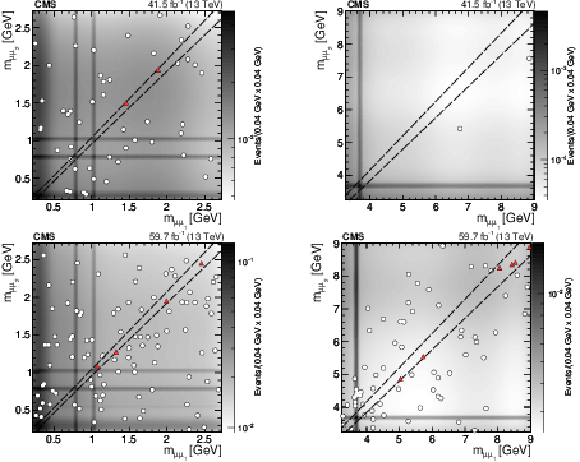
png pdf |
Figure 3:
Two-dimensional distribution of the invariant masses $ m_{\mu\mu_1} $ vs. $ m_{\mu\mu_2} $ below (left) and above (right) the $ \mathrm{J}/\psi $ resonance, for the 2017 (top row) and 2018 (bottom row) analyses. The greyscale heatmaps show the normalized QCD background templates, and the black vertical and horizontal bands correspond to the excluded regions around the $ \eta $, $\omega${783), and $\phi$(1020) resonances. The white dots represent data events that pass all selection criteria but fall outside the SR $ m_{\mu\mu_1} \simeq m_{\mu\mu_2} $ (outlined by dashed lines), and the red triangles represent data events passing all selection criteria. As discussed in Section 6.1, the paucity of events in the CR for the 2017 analysis, particularly the region above $ \mathrm{J}/\psi $, is a result of the triggers selected for this data-taking period. |
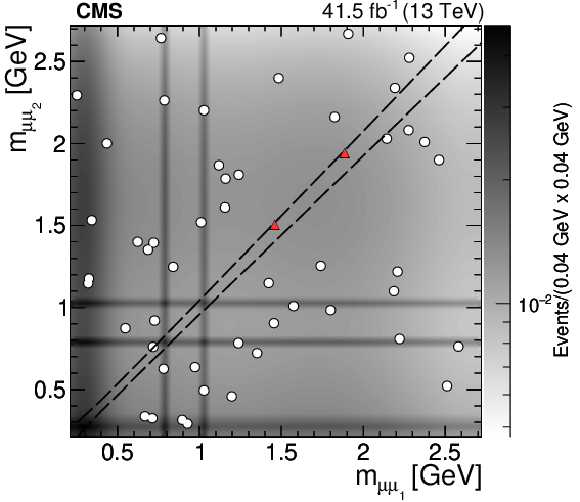
png pdf |
Figure 3-a:
Two-dimensional distribution of the invariant masses $ m_{\mu\mu_1} $ vs. $ m_{\mu\mu_2} $ below (left) and above (right) the $ \mathrm{J}/\psi $ resonance, for the 2017 (top row) and 2018 (bottom row) analyses. The greyscale heatmaps show the normalized QCD background templates, and the black vertical and horizontal bands correspond to the excluded regions around the $ \eta $, $\omega${783), and $\phi$(1020) resonances. The white dots represent data events that pass all selection criteria but fall outside the SR $ m_{\mu\mu_1} \simeq m_{\mu\mu_2} $ (outlined by dashed lines), and the red triangles represent data events passing all selection criteria. As discussed in Section 6.1, the paucity of events in the CR for the 2017 analysis, particularly the region above $ \mathrm{J}/\psi $, is a result of the triggers selected for this data-taking period. |
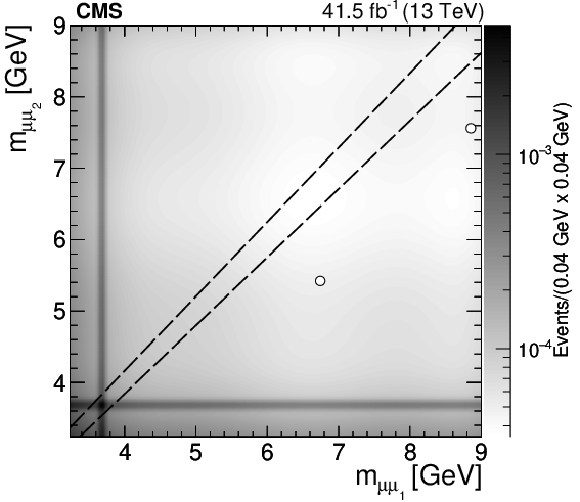
png pdf |
Figure 3-b:
Two-dimensional distribution of the invariant masses $ m_{\mu\mu_1} $ vs. $ m_{\mu\mu_2} $ below (left) and above (right) the $ \mathrm{J}/\psi $ resonance, for the 2017 (top row) and 2018 (bottom row) analyses. The greyscale heatmaps show the normalized QCD background templates, and the black vertical and horizontal bands correspond to the excluded regions around the $ \eta $, $\omega${783), and $\phi$(1020) resonances. The white dots represent data events that pass all selection criteria but fall outside the SR $ m_{\mu\mu_1} \simeq m_{\mu\mu_2} $ (outlined by dashed lines), and the red triangles represent data events passing all selection criteria. As discussed in Section 6.1, the paucity of events in the CR for the 2017 analysis, particularly the region above $ \mathrm{J}/\psi $, is a result of the triggers selected for this data-taking period. |
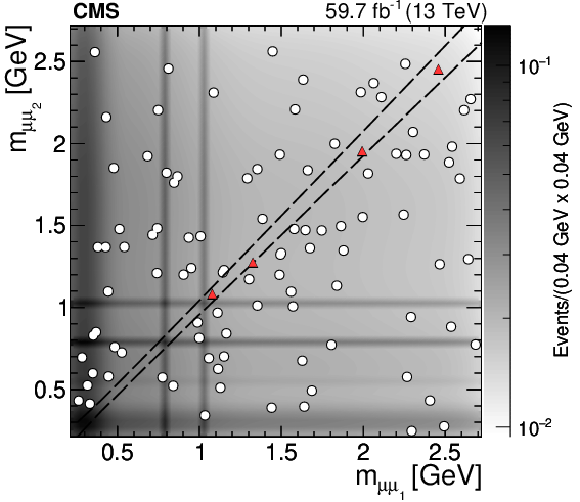
png pdf |
Figure 3-c:
Two-dimensional distribution of the invariant masses $ m_{\mu\mu_1} $ vs. $ m_{\mu\mu_2} $ below (left) and above (right) the $ \mathrm{J}/\psi $ resonance, for the 2017 (top row) and 2018 (bottom row) analyses. The greyscale heatmaps show the normalized QCD background templates, and the black vertical and horizontal bands correspond to the excluded regions around the $ \eta $, $\omega${783), and $\phi$(1020) resonances. The white dots represent data events that pass all selection criteria but fall outside the SR $ m_{\mu\mu_1} \simeq m_{\mu\mu_2} $ (outlined by dashed lines), and the red triangles represent data events passing all selection criteria. As discussed in Section 6.1, the paucity of events in the CR for the 2017 analysis, particularly the region above $ \mathrm{J}/\psi $, is a result of the triggers selected for this data-taking period. |

png pdf |
Figure 3-d:
Two-dimensional distribution of the invariant masses $ m_{\mu\mu_1} $ vs. $ m_{\mu\mu_2} $ below (left) and above (right) the $ \mathrm{J}/\psi $ resonance, for the 2017 (top row) and 2018 (bottom row) analyses. The greyscale heatmaps show the normalized QCD background templates, and the black vertical and horizontal bands correspond to the excluded regions around the $ \eta $, $\omega${783), and $\phi$(1020) resonances. The white dots represent data events that pass all selection criteria but fall outside the SR $ m_{\mu\mu_1} \simeq m_{\mu\mu_2} $ (outlined by dashed lines), and the red triangles represent data events passing all selection criteria. As discussed in Section 6.1, the paucity of events in the CR for the 2017 analysis, particularly the region above $ \mathrm{J}/\psi $, is a result of the triggers selected for this data-taking period. |

png pdf |
Figure 4:
Two-dimensional distribution of the invariant masses $ m_{\mu\mu_1} $ vs. $ m_{\mu\mu_2} $ above the $ \Upsilon $ resonances for the 2017 analysis (left) and the 2018 analysis (right). The greyscale heatmaps represent the normalized 2D probability density function of the background data. White dots represent data events that pass all selection criteria but fall outside the SR $ m_{\mu\mu_1} \simeq m_{\mu\mu_2} $ (outlined by dashed lines), and the red triangles represent data events passing all selection criteria. |

png pdf |
Figure 4-a:
Two-dimensional distribution of the invariant masses $ m_{\mu\mu_1} $ vs. $ m_{\mu\mu_2} $ above the $ \Upsilon $ resonances for the 2017 analysis (left) and the 2018 analysis (right). The greyscale heatmaps represent the normalized 2D probability density function of the background data. White dots represent data events that pass all selection criteria but fall outside the SR $ m_{\mu\mu_1} \simeq m_{\mu\mu_2} $ (outlined by dashed lines), and the red triangles represent data events passing all selection criteria. |

png pdf |
Figure 4-b:
Two-dimensional distribution of the invariant masses $ m_{\mu\mu_1} $ vs. $ m_{\mu\mu_2} $ above the $ \Upsilon $ resonances for the 2017 analysis (left) and the 2018 analysis (right). The greyscale heatmaps represent the normalized 2D probability density function of the background data. White dots represent data events that pass all selection criteria but fall outside the SR $ m_{\mu\mu_1} \simeq m_{\mu\mu_2} $ (outlined by dashed lines), and the red triangles represent data events passing all selection criteria. |

png pdf |
Figure 5:
The model-independent 95% CL expected and observed upper limits set on $ {\sigma(\mathrm{p}\mathrm{p} \to 2{a} + \mathrm{X})\mathcal{B}^2({a} \to 2\mu)\alpha_\text{Gen}} $ over the range 0.21 $ < m_{{a} } < $ 60 GeV for the 2017 and 2018 analyses (top left and top right, respectively), over the range 0.21 $ < m_{{a} } < $ 60 GeV for the combined 2017 and 2018 analyses (bottom left), and over the range 0.21 $ < m_{{a} } < $ 9 GeV for the combined 2016, 2017, and 2018 analyses (bottom right). Mass ranges that overlap with $ \mathrm{J}/\psi $ and $ \Upsilon $ resonances are excluded from the search. |

png pdf |
Figure 5-a:
The model-independent 95% CL expected and observed upper limits set on $ {\sigma(\mathrm{p}\mathrm{p} \to 2{a} + \mathrm{X})\mathcal{B}^2({a} \to 2\mu)\alpha_\text{Gen}} $ over the range 0.21 $ < m_{{a} } < $ 60 GeV for the 2017 and 2018 analyses (top left and top right, respectively), over the range 0.21 $ < m_{{a} } < $ 60 GeV for the combined 2017 and 2018 analyses (bottom left), and over the range 0.21 $ < m_{{a} } < $ 9 GeV for the combined 2016, 2017, and 2018 analyses (bottom right). Mass ranges that overlap with $ \mathrm{J}/\psi $ and $ \Upsilon $ resonances are excluded from the search. |

png pdf |
Figure 5-b:
The model-independent 95% CL expected and observed upper limits set on $ {\sigma(\mathrm{p}\mathrm{p} \to 2{a} + \mathrm{X})\mathcal{B}^2({a} \to 2\mu)\alpha_\text{Gen}} $ over the range 0.21 $ < m_{{a} } < $ 60 GeV for the 2017 and 2018 analyses (top left and top right, respectively), over the range 0.21 $ < m_{{a} } < $ 60 GeV for the combined 2017 and 2018 analyses (bottom left), and over the range 0.21 $ < m_{{a} } < $ 9 GeV for the combined 2016, 2017, and 2018 analyses (bottom right). Mass ranges that overlap with $ \mathrm{J}/\psi $ and $ \Upsilon $ resonances are excluded from the search. |

png pdf |
Figure 5-c:
The model-independent 95% CL expected and observed upper limits set on $ {\sigma(\mathrm{p}\mathrm{p} \to 2{a} + \mathrm{X})\mathcal{B}^2({a} \to 2\mu)\alpha_\text{Gen}} $ over the range 0.21 $ < m_{{a} } < $ 60 GeV for the 2017 and 2018 analyses (top left and top right, respectively), over the range 0.21 $ < m_{{a} } < $ 60 GeV for the combined 2017 and 2018 analyses (bottom left), and over the range 0.21 $ < m_{{a} } < $ 9 GeV for the combined 2016, 2017, and 2018 analyses (bottom right). Mass ranges that overlap with $ \mathrm{J}/\psi $ and $ \Upsilon $ resonances are excluded from the search. |
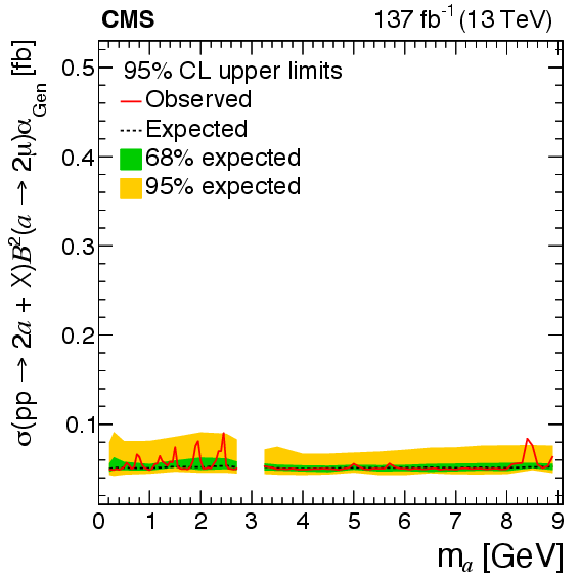
png pdf |
Figure 5-d:
The model-independent 95% CL expected and observed upper limits set on $ {\sigma(\mathrm{p}\mathrm{p} \to 2{a} + \mathrm{X})\mathcal{B}^2({a} \to 2\mu)\alpha_\text{Gen}} $ over the range 0.21 $ < m_{{a} } < $ 60 GeV for the 2017 and 2018 analyses (top left and top right, respectively), over the range 0.21 $ < m_{{a} } < $ 60 GeV for the combined 2017 and 2018 analyses (bottom left), and over the range 0.21 $ < m_{{a} } < $ 9 GeV for the combined 2016, 2017, and 2018 analyses (bottom right). Mass ranges that overlap with $ \mathrm{J}/\psi $ and $ \Upsilon $ resonances are excluded from the search. |

png pdf |
Figure 6:
Left: The 95% CL observed upper limits on the effective coupling $ C^{\text{eff}}_{{a} \mathrm{h}}/\Lambda^{2} $ of the ALP to the SM Higgs assuming the branching fraction of the ALP to muons is 1 (blue) and 0.1 (orange), for both the expected (dashed) and observed (solid) limits. Right: The 95% CL observed upper limits on the effective coupling $ C^{\text{eff}}_{ll}/\Lambda $ of the ALP to the SM leptons. The orange shaded region represents the parameter space excluded by this search under three choices of $ C^{\text{eff}}_{{a} \mathrm{h}}/\Lambda^{2} $: 1 TeV$^{-2}$ (solid), 0.1 TeV$^{-2}$ (dashed), and 0.01 TeV$^{-2}$ (dotted). |

png pdf |
Figure 6-a:
Left: The 95% CL observed upper limits on the effective coupling $ C^{\text{eff}}_{{a} \mathrm{h}}/\Lambda^{2} $ of the ALP to the SM Higgs assuming the branching fraction of the ALP to muons is 1 (blue) and 0.1 (orange), for both the expected (dashed) and observed (solid) limits. Right: The 95% CL observed upper limits on the effective coupling $ C^{\text{eff}}_{ll}/\Lambda $ of the ALP to the SM leptons. The orange shaded region represents the parameter space excluded by this search under three choices of $ C^{\text{eff}}_{{a} \mathrm{h}}/\Lambda^{2} $: 1 TeV$^{-2}$ (solid), 0.1 TeV$^{-2}$ (dashed), and 0.01 TeV$^{-2}$ (dotted). |

png pdf |
Figure 6-b:
Left: The 95% CL observed upper limits on the effective coupling $ C^{\text{eff}}_{{a} \mathrm{h}}/\Lambda^{2} $ of the ALP to the SM Higgs assuming the branching fraction of the ALP to muons is 1 (blue) and 0.1 (orange), for both the expected (dashed) and observed (solid) limits. Right: The 95% CL observed upper limits on the effective coupling $ C^{\text{eff}}_{ll}/\Lambda $ of the ALP to the SM leptons. The orange shaded region represents the parameter space excluded by this search under three choices of $ C^{\text{eff}}_{{a} \mathrm{h}}/\Lambda^{2} $: 1 TeV$^{-2}$ (solid), 0.1 TeV$^{-2}$ (dashed), and 0.01 TeV$^{-2}$ (dotted). |
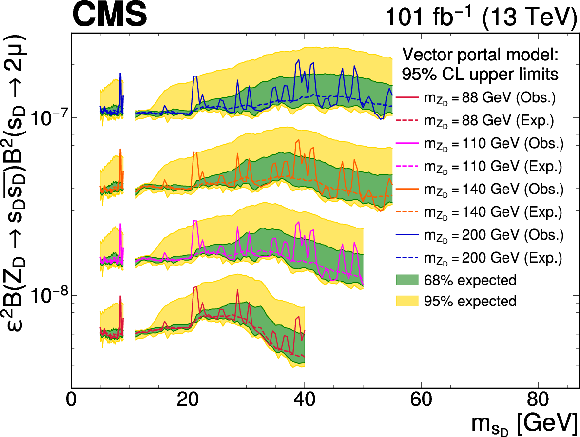
png pdf |
Figure 7:
The 95% CL observed upper limits on $ \varepsilon^{2}\mathcal{B}(Z_{\mathrm{D}} \to s_{\mathrm{D}} \overline{s}_\mathrm{D})\mathcal{B}^{2}(s_{\mathrm{D}} \to 2\mu) $ for the vector portal model as a function of the dark scalar mass $ m_{{\mathrm{s}}_{\mathrm{D}}} $ and dark vector boson mass $ m_{{\mathrm{Z}}_{\mathrm{D}}} $. Because the model-independent limits are calculated only up to a dimuon mass of 60 GeV, the $ s_{\mathrm{D}} $ mass considered for these limits is below 60 GeV. |

png pdf |
Figure 8:
The 95% CL observed upper limits for $ \sigma(\mathrm{p}\mathrm{p} \to \mathrm{h}_{1,2} \to 2{a} _{1})\mathcal{B}^2({a} _{1} \to 2\mu) $ for the NMSSM as a function of $ m_{{a} _{1}} $ for three choices of $ m_{\mathrm{h}_{1,2}} $. The left and middle plots have $ m_{\mathrm{h}_{2}} $ fixed to 125 GeV and the right plot has $ m_{\mathrm{h}_{1}} $ fixed to 125 GeV. The data presented here reflect the results of the 2017 and 2018 data sets combined with the previously published results of the 2016 data set in [32]. |

png pdf |
Figure 9:
The 95% CL observed upper limits (black solid curves) from this search as interpreted in the dark SUSY scenario for the process $ \mathrm{p}\mathrm{p} \to \mathrm{h} \to 2\mathrm{n}_{1} \to 2{\gamma}_{\mathrm{D}} + 2\mathrm{n}_{\mathrm{D}} \to 4\mu + \mathrm{X} $, with $ m_{{\mathrm{n}}_{1}} = $ 60 GeV and $ m_{{\mathrm{n}}_{\mathrm{D}}} = $ 1 GeV. The limits are presented in the plane of $ \varepsilon $ and $ m_{{\gamma}_{\mathrm{D}}} $. The color gradient represents different branching fraction assumptions for $ \mathcal{B}(\mathrm{h} \to 2\mathrm{n}_{1} \to 2{\gamma}_{\mathrm{D}} + 2\mathrm{n}_{\mathrm{D}}) $, ranging from dark orange (0.05%) to light orange (10%). The degradation of the limit around 1 GeV is attributed to the drop in the dimuon branching fraction $ \mathcal{B}({\gamma}_{\mathrm{D}} \to 2\mu) $ due to the dimuon resonance of the $ \phi $ meson [98]. |
| Tables | |
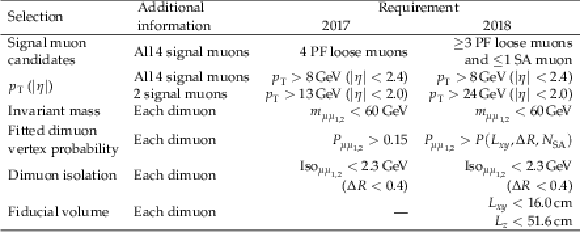
png pdf |
Table 1:
The event selection requirements for the 2017 and 2018 analyses. In the signal muon selection row, the particle-flow loose muons refer to those muons that have tracks in both the tracker and the muon system, which is contrasted with the standalone (SA) muon selection, which only requires tracks in the muon system. |

png pdf |
Table 2:
The number of observed events in the CR and the expected and observed number of events in the SR in the three mass regions considered in this analysis. |

png pdf |
Table 3:
The background estimation and mitigation method are divided into two mass regions below and above the $ \Upsilon $ resonance. The region below the $ \Upsilon $ uses the template method to estimate the background PDFs with signal-like three-muon events, which include only one dimuon and one orphan muon. The region above the $ \Upsilon $ uses the KDE method with events in the control region and involves further event selection for background mitigation. |

png pdf |
Table 4:
Results of the Baker-Cousins $ \chi^2 $ test for goodness-of-fit between the modeled background and the actual background events. For background below the $ \Upsilon $ resonances, the 2D background templates are projected into one dimension, and the test is conducted, comparing background data and template values, yielding two p-values per region per data set. A similar procedure is followed for background above the $ \Upsilon $ resonances: the 2D pdfs are projected into one dimension and the BC test is conducted, yielding two p-values for each dimuon invariant mass for both 2017 and 2018. Note that the low p-values for the mass region above $ {\mathrm{J}/\psi} $ and below $ \Upsilon $ for the 2017 data set result from the low number of background events in the data. |

png pdf |
Table 5:
The systematic uncertainties for the 2017 and 2018 analyses, including the experimental uncertainties on the signal and background, as well as the theoretical uncertainties. The experimental uncertainties on the muon identification (ID), the dimuon isolation, and the reconstruction of close muons in both the tracker and the muon system have been reproduced from [32]. Additionally, all theoretical uncertainties have been reproduced from [32]. |
| Summary |
| A search for pairs of new bosons $a$ that subsequently decay to pairs of oppositely charged muons is presented. This search is performed using data samples collected by the CMS experiment in 2017 and 2018, corresponding to 41.5 fb$ ^{-1} $ for the prompt signal in 2017 and 59.7 fb$ ^{-1} $ for both the prompt and displaced signals in 2018, for proton-proton collisions at $ \sqrt{s} = $ 13 TeV. The results are also combined with a similar analysis performed by the CMS Collaboration [32], which analyzed a smaller data set collected in 2016 corresponding to 35.9 fb$ ^{-1} $ of proton-proton collisions at $ \sqrt{s} = $ 13 TeV. Additionally, both the mass range of the boson $a$ and the maximum possible displacement of its decay vertex are extended compared to the previous version of this analysis. The distribution of events in the signal region is consistent with standard model expectations. Model-independent 95% confidence level upper limits on the product of the production cross section of pairs of new bosons, the square of the branching fraction to dimuons, and the acceptance are set over the mass range 0.21 $ < m_{{a} } < $ 60 GeV and are found to vary between 0.049 and 0.247 fb. These model-independent limits are then interpreted in the context of an axion-like particle model, a vector portal model, a next-to-minimal supersymmetric standard model, and a dark supersymmetry scenario with non-negligible boson proper decay length of up to $ c\tau= $ 100 mm. |
| References | ||||
| 1 | F. Englert and R. Brout | Broken symmetry and the mass of gauge vector mesons | PRL 13 (1964) 321 | |
| 2 | P. W. Higgs | Broken symmetries and the masses of gauge bosons | PRL 13 (1964) 508 | |
| 3 | G. S. Guralnik, C. R. Hagen, and T. W. B. Kibble | Global conservation laws and massless particles | PRL 13 (1964) 585 | |
| 4 | V. Trimble | Existence and nature of dark matter in the universe | Ann. Rev. Astron. Astrophys. 25 (1987) 425 | |
| 5 | G. Bertone and D. Hooper | History of dark matter | Rev. Mod. Phys. 90 (2018) 045002 | 1605.04909 |
| 6 | M. Maniatis | The next-to-minimal supersymmetric extension of the standard model reviewed | Int. J. Mod. Phys. A 25 (2010) 3505 | 0906.0777 |
| 7 | L. D. Duffy and K. van Bibber | Axions as dark matter particles | New J. Phys. 11 (2009) 105008 | 0904.3346 |
| 8 | N. Arkani-Hamed, D. P. Finkbeiner, T. R. Slatyer, and N. Weiner | A theory of dark matter | PRD 79 (2009) 015014 | 0810.0713 |
| 9 | L. Lee, C. Ohm, A. Soffer, and T.-T. Yu | Collider searches for long-lived particles beyond the standard model | Prog. Part. Nucl. Phys. 106 (2019) 210 | 1810.12602 |
| 10 | A. Belyaev et al. | LHC discovery potential of the lightest nmssm higgs boson in the $ {h}_{1}\rightarrow{a}_{1}{a}_{1}\rightarrow 4\mu $ channel | PRD 81 (2010) 075021 | 1002.1956 |
| 11 | M. Rahmani | Construction and testing of large-area GEM detectors for the forward muon endcap upgrade of the CMS experiment and vector-portal search for dark matter particles with dimuon pairs at $ \sqrt{s} = $ 13 TeV | PhD thesis, Florida Institute of Technology, 2022 link |
|
| 12 | D. Curtin, R. Essig, S. Gori, and J. Shelton | Illuminating dark photons with high-energy colliders | JHEP 02 (2015) 157 | 1412.0018 |
| 13 | E. Armengaud et al. | Axion searches with the EDELWEISS-II experiment | JCAP 11 (2013) 067 | 1307.1488 |
| 14 | A. Caputo and G. Raffelt | Astrophysical Axion Bounds: The 2024 Edition | in Proceedings of 1st General Meeting and 1st Training School of the COST Action COSMIC WISPers PoS(COSMICWISPers) 454 (2024) |
|
| 15 | M. Bauer, M. Neubert, and A. Thamm | Collider probes of axion-like particles | JHEP 12 (2017) 044 | 1708.00443 |
| 16 | S. Weinberg | A new light boson? | PRL 40 (1978) 223 | |
| 17 | M. R. Buckley, D. Feld, and D. Goncalves | Scalar simplified models for dark matter | PRD 91 (2015) 015017 | 1410.6497 |
| 18 | J. D. Wells | How to find a hidden world at the Large Hadron Collider | in Perspectives on LHC Physics, G. Kane and A. Pierce, eds, 2008 link |
0803.1243 |
| 19 | J. A. Aguilar-Saavedra, J. A. Casas, J. Quilis, and R. Ruiz de Austri | Multilepton dark matter signals | JHEP 04 (2020) 069 | 1911.03486 |
| 20 | D. Abercrombie et al. | Dark matter benchmark models for early LHC Run-2 searches: report of the ATLAS/CMS dark matter forum | Phys. Dark Univ. 27 (2020) 100371 | 1507.00966 |
| 21 | F. Bishara, R. Contino, and J. Rojo | Higgs pair production in vector-boson fusion at the LHC and beyond | EPJC 77 (2017) 481 | 1611.03860 |
| 22 | M. Baumgart et al. | Non-Abelian dark sectors and their collider signatures | JHEP 04 (2009) 014 | 0901.0283 |
| 23 | P. Fayet | Supergauge invariant extension of the Higgs mechanism and a model for the electron and its neutrino | NPB 90 (1975) 104 | |
| 24 | R. K. Kaul and P. Majumdar | Cancellation of quadratically divergent mass corrections in globally supersymmetric spontaneously broken gauge theories | NPB 199 (1982) 36 | |
| 25 | R. Barbieri, S. Ferrara, and C. A. Savoy | Gauge models with spontaneously broken local supersymmetry | PLB 119 (1982) 343 | |
| 26 | H. P. Nilles, M. Srednicki, and D. Wyler | Weak interaction breakdown induced by supergravity | PLB 120 (1983) 346 | |
| 27 | J. M. Frere, D. R. T. Jones, and S. Raby | Fermion masses and induction of the weak scale by supergravity | NPB 222 (1983) 11 | |
| 28 | J. P. Derendinger and C. A. Savoy | Quantum effects and SU(2) x U(1) breaking in supergravity gauge theories | NPB 237 (1984) 307 | |
| 29 | M. Drees | Supersymmetric models with extended Higgs sector | Int. J. Mod. Phys. A 4 (1989) 3635 | |
| 30 | U. Ellwanger, C. Hugonie, and A. M. Teixeira | The next-to-minimal supersymmetric standard model | Phys. Rept. 496 (2010) 1 | 0910.1785 |
| 31 | A. Falkowski, J. T. Ruderman, T. Volansky, and J. Zupan | Hidden Higgs decaying to lepton jets | JHEP 05 (2010) 077 | 1002.2952 |
| 32 | CMS Collaboration | A search for pair production of new light bosons decaying into muons in proton-proton collisions at 13 TeV | PLB 796 (2019) 131 | CMS-HIG-18-003 1812.00380 |
| 33 | CMS Collaboration | Search for light resonances decaying into pairs of muons as a signal of new physics | JHEP 07 (2011) 098 | CMS-EXO-11-013 1106.2375 |
| 34 | CMS Collaboration | Search For a non-standard-model Higgs boson decaying to a pair of new light bosons in four-muon final states | PLB 726 (2013) 564 | CMS-EXO-12-012 1210.7619 |
| 35 | CMS Collaboration | A search for pair production of new light bosons decaying into muons | PLB 752 (2016) 146 | CMS-HIG-13-010 1506.00424 |
| 36 | CMS Collaboration | Search for a very light NMSSM Higgs boson produced in decays of the 125 GeV scalar boson and decaying into $ \tau $ leptons in pp collisions at $ \sqrt{s}= $ 8 TeV | JHEP 01 (2016) 079 | CMS-HIG-14-019 1510.06534 |
| 37 | CMS Collaboration | Search for light pseudoscalar boson pairs produced from decays of the 125 GeV Higgs boson in final states with two muons and two nearby tracks in pp collisions at $ \sqrt{s}= $ 13 TeV | PLB 800 (2020) 135087 | CMS-HIG-18-006 1907.07235 |
| 38 | CMS Collaboration | Search for low-mass dilepton resonances in Higgs boson decays to four-lepton final states in proton-proton collisions at $ \sqrt{s} = $ 13 TeV | EPJC 82 (2022) 290 | CMS-HIG-19-007 2111.01299 |
| 39 | ATLAS Collaboration | Search for new light gauge bosons in Higgs boson decays to four-lepton final states in $ pp $ collisions at $ \sqrt{s}= $ 8 TeV with the ATLAS detector at the LHC | PRD 92 (2015) 092001 | 1505.07645 |
| 40 | ATLAS Collaboration | Search for Higgs bosons decaying into new spin-0 or spin-1 particles in four-lepton final states with the ATLAS detector with 139 fb$ ^{-1} $ of $ pp $ collision data at $ \sqrt{s}= $ 13 TeV | JHEP 03 (2022) 041 | 2110.13673 |
| 41 | ATLAS Collaboration | Search for light neutral particles decaying promptly into collimated pairs of electrons or muons in $ pp $ collisions at $ \sqrt{s} $ = 13 TeV with the ATLAS detector | Submitted to EPJC | 2407.09168 |
| 42 | ATLAS Collaboration | Search for new phenomena in three- or four-lepton events in $ pp $ collisions at $ \sqrt s $ = 13 TeV with the ATLAS detector | PLB 824 (2022) 136832 | 2107.00404 |
| 43 | ATLAS Collaboration | Search for Higgs boson decays into two new low-mass spin-0 particles in the 4$ b $ channel with the ATLAS detector using $ pp $ collisions at $ \sqrt{s}= $ 13 TeV | no.~11, 11, 2020 PRD 102 (2020) |
2005.12236 |
| 44 | ATLAS Collaboration | Search for the Higgs boson produced in association with a vector boson and decaying into two spin-zero particles in the $ H \rightarrow aa \rightarrow 4b $ channel in $ pp $ collisions at $ \sqrt{s} = $ 13 TeV with the ATLAS detector | JHEP 10 (2018) 031 | 1806.07355 |
| 45 | ATLAS Collaboration | Search for short- and long-lived axion-like particles in $ H\rightarrow a a \rightarrow 4\gamma $ decays with the ATLAS experiment at the LHC | no.~7, 742, 2024 EPJC 84 (2024) |
2312.03306 |
| 46 | CMS Collaboration | Search for an exotic decay of the Higgs boson to a pair of light pseudoscalars in the final state with two b quarks and two $ \tau $ leptons in proton-proton collisions at $ \sqrt{s}= $ 13 TeV | PLB 785 (2018) 462 | CMS-HIG-17-024 1805.10191 |
| 47 | CMS Collaboration | Search for exotic decays of the Higgs boson to a pair of pseudoscalars in the $ \mu\mu $bb and $ \tau\tau $bb final states | EPJC 84 (2024) 493 | CMS-HIG-22-007 2402.13358 |
| 48 | CMS Collaboration | Search for an exotic decay of the Higgs boson to a pair of light pseudoscalars in the final state of two muons and two $ \tau $ leptons in proton-proton collisions at $ \sqrt{s}= $ 13 TeV | JHEP 11 (2018) 018 | CMS-HIG-17-029 1805.04865 |
| 49 | CMS Collaboration | Search for a light pseudoscalar Higgs boson in the boosted $ \mu\mu\tau\tau $ final state in proton-proton collisions at $ \sqrt{s}= $ 13 TeV | JHEP 08 (2020) 139 | CMS-HIG-18-024 2005.08694 |
| 50 | LHCb Collaboration | Search for Higgs-like bosons decaying into long-lived exotic particles | EPJC 76 (2016) 664 | 1609.03124 |
| 51 | ATLAS Collaboration | Search for light long-lived neutral particles from Higgs boson decays via vector-boson-fusion production from pp collisions at $ \sqrt{s}= $ 13 TeV with the ATLAS detector | EPJC 84 (2024) 719 | 2311.18298 |
| 52 | ATLAS Collaboration | Search for light long-lived neutral particles that decay to collimated pairs of leptons or light hadrons in pp collisions at $ \sqrt{s} $ = 13 TeV with the ATLAS detector | JHEP 06 (2023) 153 | 2206.12181 |
| 53 | CMS Collaboration | Search for a narrow resonance lighter than 200 GeV decaying to a pair of muons in proton-proton collisions at $ \sqrt{s} = $ 13 TeV | PRL 124 (2020) 131802 | CMS-EXO-19-018 1912.04776 |
| 54 | CMS Collaboration | Search for direct production of GeV-scale resonances decaying to a pair of muons in proton-proton collisions at $ \sqrt{s} = $ 13 TeV | JHEP 12 (2023) 070 | CMS-EXO-21-005 2309.16003 |
| 55 | CMS Collaboration | Search for long-lived particles decaying into muon pairs in proton-proton collisions at $ \sqrt{s} = $ 13 TeV collected with a dedicated high-rate data stream | JHEP 04 (2022) 062 | CMS-EXO-20-014 2112.13769 |
| 56 | CMS Collaboration | Search for long-lived particles decaying to a pair of muons in proton-proton collisions at $ \sqrt{s} = $ 13 TeV | JHEP 05 (2023) 228 | CMS-EXO-21-006 2205.08582 |
| 57 | CMS Collaboration | CMS technical design report for the pixel detector upgrade | technical report, 9, 2012 link |
|
| 58 | CMS Collaboration | Calibration and performance of the CMS pixel detector in LHC Run 2 | PoS LHCP 010, 2019 link |
1909.12920 |
| 59 | CMS Collaboration | Performance of the CMS level-1 trigger in proton-proton collisions at $ \sqrt{s} = $ 13 TeV | JINST 15 (2020) P10017 | CMS-TRG-17-001 2006.10165 |
| 60 | CMS Collaboration | HEPData record for this analysis | link | |
| 61 | CMS Collaboration | Performance of the CMS muon detector and muon reconstruction with proton-proton collisions at $ \sqrt{s}= $ 13 TeV | JINST 13 (2018) P06015 | CMS-MUO-16-001 1804.04528 |
| 62 | CMS Collaboration | The CMS trigger system | JINST 12 (2017) P01020 | CMS-TRG-12-001 1609.02366 |
| 63 | CMS Collaboration | The CMS experiment at the CERN LHC | JINST 3 (2008) S08004 | |
| 64 | J. Alwall et al. | The automated computation of tree-level and next-to-leading order differential cross sections, and their matching to parton shower simulations | JHEP 07 (2014) 079 | 1405.0301 |
| 65 | P. Artoisenet, R. Frederix, O. Mattelaer, and R. Rietkerk | Automatic spin-entangled decays of heavy resonances in Monte Carlo simulations | JHEP 03 (2013) 015 | 1212.3460 |
| 66 | T. Sjöstrand et al. | An introduction to PYTHIA 8.2 | Comput. Phys. Commun. 191 (2015) 159 | 1410.3012 |
| 67 | ATLAS Collaboration | Observation of a new particle in the search for the standard model Higgs boson with the ATLAS detector at the LHC | PLB 716 (2012) 1 | 1207.7214 |
| 68 | CMS Collaboration | Observation of a new boson at a mass of 125 GeV with the CMS Experiment at the LHC | PLB 716 (2012) 30 | CMS-HIG-12-028 1207.7235 |
| 69 | CMS Collaboration | Observation of a new boson with mass near 125 GeV in $ pp $ collisions at $ \sqrt{s} = $ 7 and 8 TeV | JHEP 06 (2013) 081 | CMS-HIG-12-036 1303.4571 |
| 70 | WMAP Collaboration | Nine-year Wilkinson microwave anisotropy probe (WMAP) observations: Cosmological parameter results | Astrophys. J. Suppl. 208 (2013) 19 | 1212.5226 |
| 71 | Planck Collaboration | Planck 2013 results. XVI. cosmological parameters | Astron. Astrophys. 571 (2014) A16 | 1303.5076 |
| 72 | OPAL Collaboration | Decay mode independent searches for new scalar bosons with the OPAL detector at LEP | EPJC 27 (2003) 311 | hep-ex/0206022 |
| 73 | OPAL Collaboration | Search for a low mass CP odd Higgs boson in e+ e- collisions with the OPAL detector at LEP-2 | EPJC 27 (2003) 483 | hep-ex/0209068 |
| 74 | OPAL Collaboration | Search for neutral Higgs boson in CP-conserving and CP-violating MSSM scenarios | EPJC 37 (2004) 49 | hep-ex/0406057 |
| 75 | DELPHI Collaboration | Searches for neutral Higgs bosons in extended models | EPJC 38 (2004) 1 | hep-ex/0410017 |
| 76 | ALEPH Collaboration | Search for neutral Higgs bosons decaying into four taus at LEP2 | JHEP 05 (2010) 049 | 1003.0705 |
| 77 | ALEPH, DELPHI, L3, OPAL, LEP Working Group for Higgs Boson Searches Collaboration | Search for neutral MSSM Higgs bosons at LEP | EPJC 47 (2006) 547 | hep-ex/0602042 |
| 78 | R. Dermisek and J. F. Gunion | New constraints on a light CP-odd Higgs boson and related NMSSM ideal Higgs scenarios | PRD 81 (2010) 075003 | 1002.1971 |
| 79 | NNPDF Collaboration | Parton distributions from high-precision collider data | EPJC 77 (2017) 663 | 1706.00428 |
| 80 | CMS Collaboration | Extraction and validation of a new set of CMS PYTHIA8 tunes from underlying-event measurements | EPJC 80 (2020) 4 | CMS-GEN-17-001 1903.12179 |
| 81 | GEANT4 Collaboration | GEANT 4---a simulation toolkit | NIM A 506 (2003) 250 | |
| 82 | CMS Collaboration | Technical proposal for the Phase-II upgrade of the CMS Detector | technical report, 6, 2015 link |
|
| 83 | CMS Collaboration | Particle-flow reconstruction and global event description with the CMS detector | JINST 12 (2017) P10003 | CMS-PRF-14-001 1706.04965 |
| 84 | CMS Collaboration | Description and performance of track and primary-vertex reconstruction with the CMS tracker | JINST 9 (2014) P10009 | CMS-TRK-11-001 1405.6569 |
| 85 | J. Gaiser et al. | Charmonium spectroscopy from inclusive psi-prime and J/psi radiative decays | PRD 34 (1986) 711 | |
| 86 | S. Baker and R. D. Cousins | Clarification of the use of chi-square and likelihood functions in fits to histograms | NIM 221 (1984) 437 | |
| 87 | K. S. Cranmer | Kernel estimation in high-energy physics | Comput. Phys. Commun. 136 (2001) 198 | hep-ex/0011057 |
| 88 | CMS Collaboration | CMS luminosity measurement for the 2017 data-taking period at $ \sqrt{s} = $ 13 TeV | CMS Physics Analysis Summary, 2018 link |
CMS-PAS-LUM-17-004 |
| 89 | CMS Collaboration | CMS luminosity measurement for the 2018 data-taking period at $ \sqrt{s} = $ 13 TeV | CMS Physics Analysis Summary, 2019 link |
CMS-PAS-LUM-18-002 |
| 90 | CMS Collaboration | Search for long-lived heavy neutral leptons with displaced vertices in proton-proton collisions at $ \sqrt{{s}} = $ 13 TeV | JHEP 07 (2022) 081 | CMS-EXO-20-009 2201.05578 |
| 91 | CMS Collaboration | Performance of the CMS muon trigger system in proton-proton collisions at $ \sqrt{s} = $ 13 TeV | JINST 16 (2021) P07001 | CMS-MUO-19-001 2102.04790 |
| 92 | A. L. Read | Presentation of search results: The $ CL_s $ technique | JPG 28 (2002) 2693 | |
| 93 | T. Junk | Confidence level computation for combining searches with small statistics | NIM A 434 (1999) 435 | hep-ex/9902006 |
| 94 | CMS Collaboration | Precise determination of the mass of the Higgs boson and tests of compatibility of its couplings with the standard model predictions using proton collisions at 7 and 8 TeV | EPJC 75 (2015) 212 | CMS-HIG-14-009 1412.8662 |
| 95 | CMS Collaboration | The CMS statistical analysis and combination tool: Combine | Submitted to Comput. Softw. Big Sci, 2024 | CMS-CAT-23-001 2404.06614 |
| 96 | M. Cepeda et al. | Report from working group 2: Higgs physics at the HL-LHC and HE-LHC | CERN Yellow Rep. Monogr. 7 (2019) 221 | 1902.00134 |
| 97 | ATLAS Collaboration | Search for Higgs bosons decaying to $ aa $ in the $ \mu\mu\tau\tau $ final state in $ pp $ collisions at $ \sqrt{s} = $ 8 TeV with the ATLAS experiment | PRD 92 (2015) 052002 | 1505.01609 |
| 98 | CMS Collaboration | Search for light bosons in decays of the 125 GeV Higgs boson in proton-proton collisions at $ \sqrt{s}= $ 8 TeV | JHEP 10 (2017) 076 | CMS-HIG-16-015 1701.02032 |
| 99 | B. Batell, M. Pospelov, and A. Ritz | Probing a secluded U(1) at B-factories | PRD 79 (2009) 115008 | 0903.0363 |

|
Compact Muon Solenoid LHC, CERN |

|

|

|

|

|

|